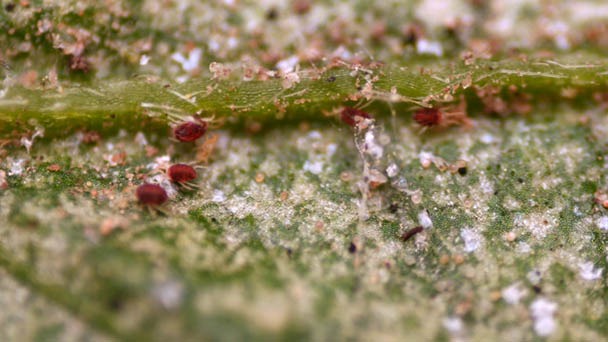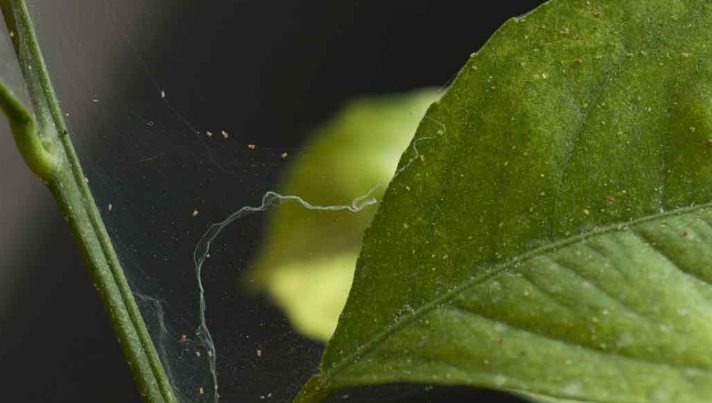Early Signs of Spider Mites - How to Get Rid of Them
Written by Ivy
Jan 30 2023

Read our post to learn more about the problem and how to treat it if you're curious about the early signs of spider mites.
- On the needles or tops of the tree leaves, there are tiny yellow or white spots.
- A bronze or yellow hue in a tree's trunk or other parts.
- Tree stems and leaves are covered in silken webs.
Spider mites feed on the sap of a variety of plants and flowers and multiply quickly, so you need to take action right away to prevent plant death.
Spider mites are tiny pests, about the size of a pinhead, making them challenging to spot.
What Are Spider Mites?
One subgenus of the Acari spider family is the spider mite. They are hard to see because of their tiny bodies, which only reach a size of 1mm.
Spider mites consume plant sap for food. As they feed, plants are affected, and some are even killed when their leaves turn yellow.
Because of their ability to wrap plants and flower buds in a silk web resembling a spider web, this type of mite is known as a "spider mite."
In case of severe infestations, spider mites wrap plants in web. As a result, dust is trapped and plants are unable to develop normally.
Only under a magnifying glass can spider mites be seen. They resemble other mites in appearance and have a red, yellow, or green body.
These insects are born with 6 legs, which they develop into 8 legs as adults.
They have a tiny, sharp mouth that they use to pierce flower buds and leaves in order to drink the sugar-rich plant sap that sustains them.
What Are the First Signs of Spider Mites?
Silver dots in a pattern, delicate web-like structures, and tiny dots on the leaves and stems are frequently the first indications of spider mites. The undersides of the leaves and stem corners will both have delicate webs. The shoot tips eventually become bald as the leaves fall, and side shoots begin to grow as a result, as the mites spread to various plant regions over time.
If you notice white or yellow spots on needles of the plant leaves or bronze-yellow spots on multiple areas of the plant, it could be due to a spider mite infestation.
The discoloration on leaves is initially speckled and becomes more prominent gradually. Between the veins, the leaves rip open and drop off.
To look for webbings and other early signs, you might have to turn the leaves over. Shake the leaf while holding a white piece of paper beneath it. If the plant is being attacked by mites, you may notice some mites dropping on it. Since they are so small, they won't be noticeable unless the population is extraordinarily high.
Can Spider Mites Come Out of Nowhere?
Spider mites frequently appear as though they have suddenly appeared, but if you look closely, you may find that they have been present around the plants all along. They don't draw attention because of their small size and only appear when the climate is warm and conducive to their growth.
When their population dramatically rises, spider mites, which grow in colonies, become visible to the naked eye. Multiple plant regions are impacted as they proliferate. On the undersides of leaves, where they are shielded from moisture and direct air, spider mite eggs are most commonly found.
For more information, see Can You Put Potting Soil in Compost? (And in the Garden?)Pests known as spider mites are ravenous and frequently appear out of nowhere. They consume the plant leaves by puncturing their veins and sucking up all the plant juices. Make sure any other pest infestation is eliminated because some pests, like mealybugs, also consume plant sap.
Where Do Spider Mites Come From?
Spider mites use the wind to move from one location to another. They are incredibly simple to transport over long distances due to their light weight and small size. Through shoes, clothing, animal fur, and other infected plants, they can get into your home garden. It gets challenging to see these cunning pests soon due to their tiny size.
Female mites build a cocoon around themselves and lay eggs on the undersides of leaves in the spring. The more warm and dry your region is, the greater the likelihood of an infestation because spider mites prefer these conditions. Up to seven generations can be born each year if the weather is good.

What Do Spider Mites Look Like?
Eight-legged, tiny spider mites can only be seen up close with a magnifying glass. To precisely identify the presence of spider mites, use a magnifying glass. They appear to be tiny, moving dust particles without a magnifying glass.
Spider mites are not actual spiders, despite their appearance. They are arachnids that feed on juices on leaves and stems. They live in colonies and reproduce quickly. Mite-produced webs envelop infected plants. From vultures and other raptors, the webbing offers some protection.
A spider mite measures approximately 0.5 inches in length. Its body is eight-legged and oval and is a transparent green color. The body color can occasionally change from red to brown. You can see two dark spots on its back when you use a magnifying glass. Only white webbings on leaves and stems will be visible in severe infestations.
Do Spider Mites Go Away on Their Own?
Spider mites are hard to get rid of because of their tiny size. As long as the plant is alive, they won't disappear on their own. You must take the required actions to treat the plant and stop its spread. As long as there is food nearby, they will remain on the plant.
Read more about Can Compost Catch Fire? (And How Can Overheating Be Prevented?)The plants may occasionally stop being infested if the infestation is not too bad and they are frequently sprayed with water. Apply neem oil or a soap solution to the leaves and stems on a regular basis to ensure that they are completely gone. It aids in stopping the spread and expansion of pests.
Spraying the plant with a garden hose helps remove them from leaf undersides and corners. If the numbers are small, they might disappear by themselves. To stop the spread, though, you'll need to treat them with an insecticide or soap solution.
Since mites are attracted to dusty plants, we suggest keeping the dust minimum on the plants to prevent them from spreading. Keep a humidifier or a humidity tray close to the plants to maintain high humidity levels and prevent dry soil conditions.
How Quickly Do Spider Mites Spread?
Spider mites are relatively small, but if you ignore the early symptoms, they can spread quickly. In as little as two weeks, you can see them assuming control of a small plant. They can spread to other plants in three to four weeks.
This means that you have about two weeks before the mites completely destroy the plant and spread to other plants in your garden.
Fruits on fruit trees and plants either don't fully mature or drop off too soon. Low humidity and high temperatures favor the growth of spider mites.
Neem oil and other organic mite control techniques should be used as preventative measures, and pesticides should be changed periodically, because they become comfortable above 80 degrees Fahrenheit and begin to resist pesticides.
Since mites dislike dusty environments, we typically do not find them in soil. Their main source of food is leafy plants with high levels of nitrogen, phosphorus, and carbohydrates. They pierce plant cells and extract the leaf sap.
Chlorophyll is one of the many things that the mites will feed on once they start to spread. The plant's leaves begin to turn yellow as a result of this lack of chlorophyll.
How to Prevent Spider Mites
Drought season is when spider mite attacks occur because they prefer stressed plants. Keep your plant hydrated during hot, dry spells by giving it at least one inch of water per week and enough mulch.
FAQs
Can Spider Mites Live on Humans?
Feeding only on plant sap, spider mites. They can't live off of people.
Spider mites can spread through people, but they cannot live on people.
Only a few days to a few weeks are sufficient for spider mites to survive in the absence of food. All surfaces other than plants will cause them to perish.
Can Spider Mites Bite Humans?
Similar to spiders, spider mites cannot venomously bite humans. With their pointed mouthparts, they can pierce skin at the surface.
Due to spider mites' small size and inability to be felt on the skin, these efforts largely go unnoticed.
Can Spider Mites Live in the Soil?
During the summer, when they are active, spider mites cannot survive in the soil.
In the winter, when they go dormant, they are the only ones who live underground.
When there are no plants nearby for them to feed on, spider mites fall to the ground and perish.
Do Spider Mites Die in Cold Weather?
In the winter, spider mites go into a dormant state where they are completely inactive and stop feeding.
This dormant state is typical of the chilly months that follow a plant's death. In the spring, which is also when many gardens are treated against these bugs, they begin to reappear.
Also Read How to Get Rid of the Following Species:
Animals:
- Ant
- Brown Recluse Spiders
- Hornets
- Palmetto Bugs
- Water Bugs
- Black Caterpillars
- Grass Flies
- Carpenter Bees
- Beetles
- Scorpions
Summary
Spider mites attack garden plants and thrive in dry, hot environments.
When the temperature rises above 80 degrees, these mites molt in 2 to 3 days.
They begin feeding on plant sap as soon as they hatch. Within five days of beginning to lay eggs, spider mites are sexually mature. Strawberries, tomatoes, cannabis, and corn are a few of the plants that are frequently afflicted by spider mites.
Read More:
Latest Updated
- How To Get Rid of Ant Bites Overnight - Home Remedies
- How to Get Rid of Brown Recluse Spiders - 2023 Guide
- How To Get Rid of Hornets with Simple Steps
- How to Get Rid of Palmetto Bugs with Simple Methods
- Early Signs of Spider Mites - How to Get Rid of Them
- How To Get Rid Of Water Bugs with 8 Effective Methods
- How to Get Rid of Grass Flies - Pest Control & Treatment
- How To Get Rid Of Carpenter Bees - What Is The Best Deterrent
- How to Get Rid of Beetles in Your Garden & Yard - 2023 Guide
- How To Propagate Panda Plant (Kalanchoe Tomentosa)
Popular Articles
- Winter maintenance of Antirrhinum Majus
- How to Grow Terminalia Mantaly Tree
- How to Grow and Care for Crossostephium Chinense
- How to grow Antirrhinum Majus in spring
- Peristeria Elata (Dove Orchid) Profile: Info & Care Guide
- Underwatered Snake Plant (Sansevieria Trifasciata) - Signs And How To Fix
- How to Care for Brazilian Jasmine Plant (Mandevilla Sanderi)
- How to Grow & Care for Graptopetalum Purple Delight in Summer
- Rosa Chinensis (China Rose): Plant Growing & Care Tips
- How to Care for Baby Sun Rose (Aptenia Cordifolia)